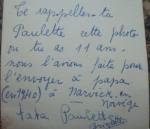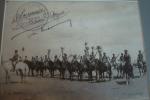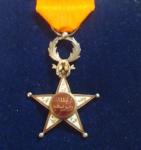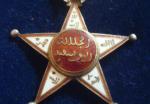-
Posts
267 -
Joined
-
Last visited
-
Days Won
1
Content Type
Profiles
Forums
Blogs
Gallery
Events
Store
Everything posted by ralstona
-
Veteran, Thanks for all your help. I am not in doubt about his right to wear it. The evidence for that is rock solid. I just want to know which unit he was with when he earned the right to wear it. He also earned an individual CdG TOE which I also believe was for Syrie. Art
-
Great Michael, that would be great. Here is a picture of my great-grandfather wearing his fourragere. This picture was taken in 1932 when he was Adjudant-Chef of the 2nd Tirailleurs Algerien. It was taken in Mostaganem. This was from his time in between his Legion service and being recalled as a reservist for the 13eme DBLE in 1940. As you can see he is wearing a different fourragere than his men. My uncle has his CdG TOE fourragere today.
-
The 4th was definitely there. Both the 4e and 5e battalions at different times. The 5/4 was at Messifre with the 1 REC. Here is a quote from a website about the 4e REI. "Dans le même temps, le 4ème puis le 5ème bataillon du 4 s’illustrent au Levant, entre 1921 et 1926." Art
-
So this is confusing me. Did the V/IV REI earn a fourragere or not? They were definitely there. Some places say yes, some say no. Hmm?
-
Hi, Here is a link to the mention of the 5/4 REI and its fourragere. http://books.google.com/books?id=zv6egv9EsjwC&q=syria+1925#v=snippet&q=syria%201925&f=false It is the reference on page 43. D2 refers to the 5/4. Again I am not sure he was with this unit, he might have been with the 1 REC which seems more definite on the fourragere. In his final dossier he lists under his awards a Fourragere CdG TOE (a titre personnel). Art
-
Veteran, Thanks, I think I understand how it works now. I saw that sight too, but I am confused. He definitely didn't serve with any of those units. In the Men-At-Arms: Foreign Legion 1914-1945 it states that the V/IV REI won a CdG TOE fourragere for the action 17 sept 25 (Messifre) and the 1/REC won it for the action at Rachaya 20-23 Nov. 1925. If you search for "R.E.C. Fourragere 1925" several sites confirm this. So again, I am lost. Art
-
So this of course connects to my great-grandfather again. He earned a fourragere "a titre personnel" of the CdG T.O.E. I believe this was for Syria in 1925. He fought at the Battle of Messifre in the Druse War. He was either with the 5e/4e REI or the company of the 1 REC which were there. I can't quite figure out which. His unit at this point is a bit confusing. He went to Syrie in 1923 with 4e/4e REI and served in "Mesopotamia" and the "Confines of the Euphrates" on "policing" duties. The 4e battalion then went back to Algeria and was replaced by the 5e battalion of the 4e REI. He either stayed on with the 5e or transfered to the 1e REC which was their by that time. Both the 5/4 and the 1 REC (one company) fought at Messifre and earned a fourragere for their unit. Art
-
What happens if they go to a unit that also wears a fourragere? Do they wear both? If the unit they were with goes on to earn more citations, do they "upgrade"? Art
-
Hello all, I am not 100% sure I understand what it means to be "awarded" a fourragere "a titre personnel". How did this work? Any help appreciated. Art
-
Thanks Bernhard! No, actually I didn't realize that. I am constantly adding to this story. He certainly was in illustrious company. Of the three Lieuts. in his company 2 went on to command the 13eme DBLE. The three taken together illustrate an interesting case study of the Legion. Brunet de Sarigne and Arnault were both young, French and St. Cyr graduates. My great-grandfather was considerably older, Swiss and had risen through the ranks from Legionnaire 2nd class in 1914 at age 16. After Narvik Brunet de Sarigne and Arnault stayed with DeGualle. My great-grandfather returned to Algeria. This certainly fits with what I have read about the split of the 13eme in England. Older officers, especially those with children (my great-grandfather had two by that point) tended to return to Algeria. I wonder if he was placed with these two "youngsters" to steady them. By that point he had "been there" as they say.
-
Veteran, Thank you so much for your thoughts. Again, I am indebted. Two more questions: 1. If I went to Paris (hope to in the next couple years), could I get into the Chateau de Vincennes myself and inquire? 2. I include below some photos of a few pieces of his final dossier from 1950. It shows he was back at it again in 1943 (where he was wounded) in Algeria and then went to France (1944-45). I have no idea what unit he was with at this point. I think the two "commands" listed at the very end refer to WWII. This first is for Norway (?) The second is for France (44-45)? Is "Q.G." Quartermaster-General? Any help would be appreciated. I also included my FAVORITE piece of his resume. 39 battles!
-
First let me say how much I have appreciated the help offered here so far in my quest to tell the full story of my great-grandfather, Ernest Frederic Hauser. My original post "French Foreign Legion Medal Group" has received lots of looks and it has provided me with some invaluable info. I wanted to start a new one dealing specifically with his Legion d'Honneur. Here are the details I know: 1. He was mobilised on 28 August 1939. 2. At the time he was 1st Lieut. of Reserves living in Oran, Algeria. 3. He had served with the Legion in WWI, in Morocco, in Syrie during the Druse War. Rising from a Legionnaire. 4. He volunteered for the Corps Expeditionnaire Norvegien in 1940. 5. He served as one of three Lieutenants (along with Brunet de Sairigne & Arnault) in the 7th Company (commanded by Capt. Kovaloff) of the 2nd Battalion (Commanded by Gueninchault) of the 13eme DBLE. 6. He was awarded the Legion of Honor (Chevalier) which was recorded "au tableau special de la Legion d'Honneur" on 4th October1940. It was issued by the Vichy government and he received notification on14 January 1941. 7. At the time he was Lieut. de reserve living on Rue de Mulhouse, Oran. (He didn't stay with DeGaulle in England). 8. The "family legend" is that he won his LdH saving the life of a war correspondant. Here is what I would still like to know: 1. Is their any way to find the details of the event that led to his award. 2. I have never really understood the rank place of the LdH. I know it was "France's highest honor". But where would his fit, say, in the British equivalent of awards. Is this a mentions, a Military Cross, a DSO or a VC? 3. How rare is this award? Are there numbers on awards of the LdH for Norway? I can't imagine it was too many. 4. How rare is it to have been awarded a LdH (or any award) by Vichy for fighting the Nazis? 5. If he had stayed with DeGaulle in England instead of returning to Algeria, would he have still received the award? To add some life to this story, I recently found a picture at my grandmother's house. It is a picture of her in 1940. I have seen the picture many times. I never bothered to look at the back. The inscription says, "Paulette this is a photo of you at 11 years old. It was taken just before the departure of your father (in 1940) for Narvik in Norway." The studio stamp is from a studio at 27 Rue d'Arzaw, Oran. Kind of sent chills to think he had this picture with him.
-
Hello Claudio, Great to hear we have a connection. Where do you live? My great-grandfather was born in Montreaux in 1898. He joined the Legion in 1914 at age 16. He was wounded on 9 May 1915 at Carncey during the 2nd Battle of Artois which was the attempt to take Hill 140 (Vimy Ridge).
-
Here is a picture of his unit in Morocco. He is the one holding the flag. He isllabeled as "B. Hauser" ("B" for Brigadier). The other two identified individuals are "Lt. de Marion" and "S. Spangenberg". I assume the "S" is Sergeant not his first initial. At the top it says "Peloton Monte --- 4th Regiment de la Legion Etrangere" This is in the stamp. Peloton Monte is "Mounted Company". It is signed over the stamp "Souvenir du Peloton Monte -- de Marion".
-
An update ... I decided to try and get good examples of my great-grandfathers missing medals. First up was his missing Ouissam Alaouite (Chevalier). I have been searching for one of the early versions (with text on the arms of the star) for awhile. Not easy to find. There seems to be 100 of the post-1950 versions (no text in arms) for every 1 of these early ones. He earned this for the Rif War (he was in Marocco from 1919-1923). Not sure what he did to earn it. His resume states that there was a Dahir (Moroccan Royal Decree) that went with it but this is sadly missing too. He was with the Mounted Company of the 4th REI from the time it was created on Nov. 15, 1920. Before that he had been with the 2nd REI at Meknes. While in Morocco he rose in rank from Legionnaire 1st Class to Brigadier (Caporal) to Farrier Sergeant to Sergeant-Major by 23 Oct. 1923. Note the cavalry ranks ... apparently because they were mounted. It feels good to have this medal "home". I know it's not the exact one he earned but it still seems right. Now I need to find a Medaille Colonaile with clasps Maroc and Sahara and a WWII commemorative medal with four bars (including Novege - which won't be easy).
-
You are right! All this time I've had it matched up with the wrong medal. Curse my horrible French skills. Art
-
I think we might be confusing two different units. Glubb was the Arab Legion which is different than the T.J.F.F. I think several British units wore this kalpaks (I know for a fact that the Palestine Police did). I always surmised that they wore them because people in the area were used to seeing people in positions of authority wearing them. The Ottomans had worn them before. There are several famous pictures of Kemal wearing one. Art
-
Rob, Saida is in extreme NW Algeria, right on the Morocco border. I think these documents cause a bit of confusion. Even though they call the medal the "Medaille de la Victoire" I don't think it is for the inter-allied victory medal but the "Grande Guerre" commemorative medal. The give away is the mention of "rouge" (red) and "blanc" (white) stripes (filet). I could be wrong. Would love to know for sure. Art
-
Rob, I have an almost identical document to the last you posted for my Great-Grandfather. It was issued by his unit, the 2e Regiment Legion Etranger on June 10 1920. He was in Saida at the time.













